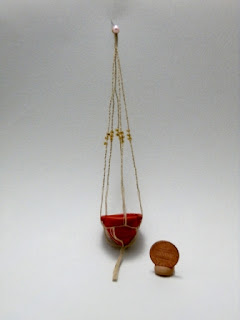I've been busy setting and divulging DHB Club. It's a member-only-access international bilingual social network website, kind of like Facebook, but without the annoying ads. It's also free! Check it out here. So, while I didn't have time to finish the next step on my 19th century store, I did try to organize my workspace a bit. And while doing it, I came across a DIY kit I got from a store in Canada - it's closing down as their owners are retiring - for a plant hanger in macrame.
 |
| acho que esse kit era da década de 70 ou 80! I think this kit was from the 70's or 80's! |
Nope, I have never tried macrame before! :) But I have some nice memories of those from my childhood, when they were more common and also very fancy. So, I decided to give it a try. Well... it takes time! :) Knot by knot, one plant hanger might take as much as 2 days to be finished... But something was very wrong with mine. It didn't look quite as the ones I remembered, check it out:
Eu até achava que tinha acertado na maioria das 'alças' do suporte, mas ainda assim parecia estranho. Então pesquisei no Youtube por vídeos que ensinassem a fazer macramê na escala normal. Até então eu só tinha a folhinha com o tutorial escrito e algumas imagens para seguir, então podia bem estar fazendo tudo errado.
I even think I got each most of the 'legs' of the hanger right, but it seemed so off. So I went ahead and searched on Youtube for some video tutorials on life size macrame. I only had a written tutorial with some drawings to follow, so I might be doing something wrong.
De fato, achei dois vídeos excelentes, que recomendo totalmente. Esta senhora, thecraftingcorner, tem vários vídeos curtos onde ensina muito bem como fazer os nós básicos. E este outro vídeo, da macrame school, é um vídeo maravilhoso sobre um suporte para plantas muito lindo.
I did find two excellent videos, which I totally recommend. This lady, thecraftingcorner, has several short videos where she explains really well how to make the basic knots. And this other video, by macrame school, is a wonderful video of a beautiful plant hanger.
Alerta: se você quiser assistir este último vídeo para aprender a fazer macramê, desligue o som. Ela realmente escolheu uma música linda, mas é tão suave, e assistir ela trabalhar, nó por nó, também é tão relaxante, que se você deixar o som ligado, pode sem querer descobrir a cura para sua insônia, hahaha!
Word of caution: if you watch this last video to learn how to make macrame, turn the sound off. She chose a beautiful soundtrack, but it's so relaxing, and watch her go, knot by knot, is also so soothing, that if you leave the sound on, you might find the cure for your insomnia, lol!
De qualquer forma, notei que uma característica em comum é que o fio, ou melhor, o cordão usado era sempre um tanto grosso, variando entre 5 mm e 10 mm. E o fio de costura fornecido no kit era fino demais!!! Ele equivaleria a um fio de uns 2 mm no máximo, na escala normal. Por isso ficou tão estranho!...
Anyhow, I noticed that a common feature was that the thread or cord used was kind of thick, varying from 3/16" to 5/16". And the sewing thread provided in the kit was way too thin!!! It would translate into something smaller than a 1/16" in life size. That's why it was so off!...
Bem, com isso resolvi tentar de novo. Usei um fio um pouco grosso demais desta vez, que equivaleria a uma corda na escala normal. Mas eu já vi suportes de plantas em fotos na internet com uns 2 metros de altura e com mais de 50 cm de largura, feitos de corda, então não está tão fora de escala assim. E, o melhor, desta vez o trabalho aparece, eba! :)
Well, I gave it another try. This time I used a much thicker thread, kind of like a rope in miniature. It is a little bit too large, but I've seen plant hangers as tall as 8 feet and 15" wide, made of actual rope. So, it's ok. And the knot work does show this time, yay! :)
 |
| Até que não ficou nada mal, não é? :) Not too bad, right? :) |
Next time I'll use some crochet threads, I bet they'll look great! :)
.
 |
| Obrigada! Thank you! |











































